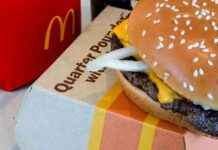Sign up for one of our email newsletters.
Updated 43 minutes ago
After learning his 9-month-old daughter had lead poisoning during a routine pediatrician visit last summer, Brandon Blache-Cohen and his wife were perplexed.
They needed to know the lead’s source — water, soil or paint — as soon as possible.
They quickly submitted a water sample from their 1920s Squirrel Hill home for lead testing, a free service the Pittsburgh Water and Sewer Authority offers to its 83,000 residential customers.
After two months, the couple still had not received a result, Blache-Cohen said.
Of the 3,057 water samples PWSA customers sent to be tested for lead last year, more than half — 1,612 — took longer than a month to get results, according to authority data the Pittsburgh Tribune-Review obtained through a Right-to-Know Law request.
PWSA estimates customers should receive results three to three and a half weeks after the lab receives the sample, according to its webpage on lead testing.
When customers received their results, about 11 percent of samples — 333 — learned bad news: The lead level exceeded a key federal regulatory threshold of 15 parts per billion.
On Thursday, a PWSA flush and boil advisory that affected 60 percent of the city was lifted after nearly two days, prompting city and PWSA officials to refocus on lead reduction efforts.
“We’d like to advance that. We’d like to be more aggressive,” said Kevin Acklin, chief of staff to Mayor Bill Peduto, referring to an U.S. Environmental Protection Agency mandate to replace lead service lines.
Results
After waiting two months for a result, Blache-Cohen contacted his Pittsburgh City Council representative, Councilman Corey O’Connor of Squirrel Hill.
After that, a PWSA representative called to give him the results — 8.2 ppb, Blache-Cohen said. It took another month to get the results in writing.
“It was a frustrating experience — the lack of transparency and, most importantly, the lack of communication,” Blache-Cohen said.
He later learned the source of the lead in his daughter’s blood was likely paint in the family’s home or a neighbor’s.
“We had the means and resources to hire a private inspector to help us, but we found ourselves really concerned about a large portion of our community that wouldn’t have that resource,” Blache-Cohen said.
O’Connor, who represents Hazelwood, Glen Hazel, Greenfield, Hays, Lincoln Place, New Homestead, Regent Square, Squirrel Hill South and Swisshelm Park, has received seven requests for help with delayed PWSA test results from his constituents since July, said Curt Conrad, O’Connor’s chief of staff.
“Usually by the time they come to us, they’ve already gone through the PWSA process and contacted customer service,” Conrad said.
County Controller Chelsa Wagner waited four months to get results for her Squirrel Hill home.
Wagner sent in a sample in late August, but PWSA lost it, Will Pickering, a PWSA spokesman, confirmed.
At the end of October, Wagner inquired about the status of her sample. PWSA sent two more kits in mid-November, Pickering said. The results arrived Dec. 20 — one of which came back 26 ppb, well over the EPA threshold.
In a December performance audit, Wagner criticized the Allegheny County Health Department for not doing enough to combat the issue of lead in water.
While some customers wait months for test results, others wait weeks to receive the lead testing kit.
Jesse Perkins requested a test kit for his Lawrenceville home, but after waiting a month, it hadn’t arrived, he said. The kits are supposed to arrive 10 to 14 business days from the time requested, according to PWSA’s website.
He asked a PWSA board member for help, and after going through a few different people, he eventually got a kit.
“It wasn’t a smooth process,” Perkins said.
The results in December showed 64.8 ppb — more than five times the EPA threshold.
Scattered results
Of the 10 ZIP codes where at least 100 households submitted samples, the 15211 ZIP code had the highest percentage that tested above 15 ppb. From that ZIP code, which includes the Mt. Washington and Duquesne Heights neighborhoods, 27 of the 131 household samples received — 20.6 percent — showed more than 15 ppb of lead.
The 15207 ZIP code had the second-highest number of samples above 15 ppb — 16 of 102, or 15.6 percent. That ZIP code contains Hazelwood, Greenfield, Glenwood, Glen Hazel, Hays and Lincoln Place.
In looking at the sample results, it’s important to note that the tests are far from scientific, Pickering said.
The tests are voluntary, and people who know they likely have lead service lines are more likely to send in a sample, Pickering said. There’s also room for human error, when people don’t follow or understand the kit’s directions.
PWSA hasn’t been able to detect a pattern in the lead test results.
“Originally we were hoping there would be entire streets with the problem,” Pickering said. “From an engineering aspect, it’s easier to remove all the (lead lines) on one block. But there really aren’t those neighborhood hot spots people want to expect.”
That risk is especially high for an aging city like Pittsburgh.
About 20 to 25 percent of PWSA’s residential customers have lead service lines, typically the source of lead in PWSA water. The authority has started a replacement program for lead pipes in public spaces.
Residents of the 15217 ZIP code, which includes Squirrel Hill and Greenfield, submitted the most water samples for lead testing in 2016. Of 763 samples, 85 tested above 15 ppb — 11 percent.
PWSA doesn’t plan to replace more pipes in the 15217 ZIP code because there were more tests, Pickering said.
“We’re making every effort to evenly distribute the replacement works throughout the city,” he said.
Increased demand
The authority typically receives about 25 requests for lead test kits a year. Last year, it received more than 6,000 requests. About half submitted samples, Pickering said.
Test requests increased after the Flint, Mich., water crisis, which gained national attention in the fall of 2015. The Trib reported in January 2016 that PWSA’s lead levels were near the EPA’s threshold of 15 parts per billion.
In July, when PWSA’s 90th percentile water sample result of 22 ppb officially exceeded the EPA 15 ppb threshold, prompting PWSA to send out letters reminding customers about free tests, the number of samples submitted increased, Pickering said.
PWSA will send out a similar letter this month, Pickering said, after the authority’s December 90th percentile result dipped to 18 ppb — still in excess of the threshold.
To handle the increased demand, PWSA now contracts with two labs for lead testing. At one point in 2016, the authority used three labs, but it dropped one because of performance issues such as long wait times, Pickering said.
To reduce issues with the free lead testing process, PWSA made changes in September, including shifting responsibility from PWSA to the lab to deliver and receive test kits and results and enter data.
“We felt it was the right thing to do to offer the free testing, but we knew there were missteps,” Pickering said. “We’re now fully confident the existing process is working.”
The expectation now is that no one should be waiting longer than a month, Pickering said.
PWSA customers can email servicelines@pgh20.com to request a test or check on the status of a test. Those who have been waiting more than a month are encouraged to do so, Pickering said.
Our editors found this article on this site using Google and regenerated it for our readers.







